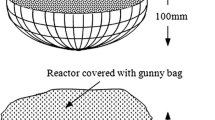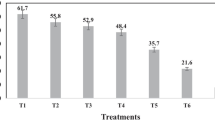Abstract
The potential of the epigeic earthworm Eisenia fetida to stabilize sludge␣(generated from a distillation unit of the sugar industry) mixed with cow dung, in different proportions i.e. 20% (T1), 40% (T2), 60% (T3) and 80% (T4) has been studied under laboratory conditions for 90 days. The␣ready vermicompost was evaluated for its’ different physico-chemical parameters using standard methods. At the end of experiment, all vermibeds expressed a significant decrease in pH (7.8–19.2%) organic C (8.5–25.8%) content, and an increase in total N (130.4–170.7%), available P (22.2–120.8%), exchangeable K (104.9–159.5%), exchangeable Ca (49.1–118.1%), and exchangeable Mg (13.6–51.2%) content. Overall, earthworms could maximize decomposition and mineralization efficiency in bedding with lower proportions of distillery sludge. DTPA extractable metal reduction in substrate was recorded between the ranges of 12.5–38.8% for Zn, 5.9–30.4% for Fe, 4.7–38.2% for Mn and 4.5–42.1% for Cu. Maximum values for the mean individual live weight (809.69 ± 20.09 mg) and maximum individual growth rate (mg wt. worm−1 day−1) (5.81 ± 0.18) of earthworms was noted in T1 treatment, whereas cocoon numbers (69.0 ± 7.94) and individual reproduction rate (cocoon worm−1 day−1) (0.046 ± 0.002) was highest in T2 treatment. Earthworm mortality tended to increase with increasing proportion of distillery sludge, and maximum mortality in E. fetida was recorded for the T4 (45.0 ± 5.0) treatment. Results indicate that vermicomposting might be useful for managing the energy and nutrient rich distillery sludge on a low-input basis. Products of this process can be used for sustainable land restoration practices. The feasibility of worms to mitigate the toxicity of metals also reduces the possibility of soil contamination, which has been reported in earlier studies during direct field application of industrial wastes.
Similar content being viewed by others
References
Barois, I., Lavelle, P. (1986). Changes in respiration rate and some physiochemical properties of a tropical soil during transit through Pontoscolex corethrurus (Glossoscolecidae, Oligochaeta). Soil Biology & Biochemistry, 18, 539–591.
Delgado, M., Bigeriego, M., Walter, I., & Calbo, R. (1995). Use of California red worm in sewage sludge transformation. Turrialba, 45, 33–41.
Edwards, C. A., Dominguez, J., & Neuhauser, E. F. (1998). Growth and reproduction of Perionyx excavatus (Perr.) (Megascolecidae) as factors in organic waste management. Biology & Fertility of Soils, 27, 155–161.
Elvira, C., Sampedro, L., Benitez, E., & Nogales, R. (1998). Vermicomposting of sludges from paper mill and dairy industries with Eisenia andrei: A pilot scale study. Bioresource Technology, 63, 205–211.
Garg, V. K., & Kaushik, P. (2005). Vermistabilization of textile mill sludge spiked with poultry droppings by an epigeic earthworm Eisenia foetida. Bioresource Technology, 96, 1063–1071.
Graff, O. (1982). Vergleich der Regenswurmaten Eisenia foetida and Eudrilus eugeniae Hinsichlich Ihrer Eignung zur Proteinwinnung aus Abfallstoffen. Pedobiologia, 23, 277–282.
Gupta, S. K., Tewari, A., Srivastava, R., Murthy, R. C., & Chandra, S. (2005). Potential of Eisenia foetida for sustainable and efficient vermicomposting of fly ash. Water Air & Soil Pollution, 163, 293–302.
Hartensein, R., & Hartenstein, F. (1981). Chemical changes affected in activated sludge by the earthworm Eisenia foetida. Journal of Environmental Quality, 10, 377–382.
Jackson, M. L. (1975). Soil chemical analysis. Pranctice Hall of India: New Delhi.
Kale, R. D. (1998). Earthworms: Nature’s gift for utilization of organic wastes. In C. A. Edwards (Ed.), Earthworm ecology, soil and water conservation society (pp. 355–373). New York: Ankeny, Lowa St. Lucie Press.
Le Bayon, R. C., & Binet, F. (2006). Earthworm changes the distribution and availability of phosphorous in organic substrates. Soil Biology & Biochemistry, 38, 235–246.
Mitchell, A. (1997). Production of Eisenia fetida and Vermicompost from Feed-lot Cattle Manure. Soil Biology & Biochemistry, 29, 763–766.
Ndegwa, P. M., Thompson, S. A., & Das, K. C. (2000). Effects of stocking density and feeding rate on vermicomposting of biosolids. Bioresource Technology, 71, 5–12.
Neuhauser, E. F., Loehr, R. C., & Makecki, M. R. (1988). The potential of earthworms for managing sewage sludge. In C. A. Edwards, & E. F. Neuhauser (Eds.), Earthworm in waste and environmental management (pp. 9–20). The Hugue: SPB Academic Publishing.
Olsen, S. R., Cole, C. V., Watanabe, F. S., & Dean, L. A. (1954). Estimation of available phosphorus in soils by extraction with sodium bicarbonate. Circular US Department of Agriculture p. 939.
Senappa, C. O., Rao, C. B. J., & Kale, R. D. (1995). Conversion of distillery wastes in to organic manure using Eudrilus engeniae King. In: Proceeding of 3rd International Conference on Appropriate Waste Management Technology For Developing Countries, 25-2, NEERI, Feb., 1165–1169.
Simard, R. R. (1993). Ammonium acetate extractable elements. In R.␣Martin, & S. Carter (Eds.), Soil sampling and methods of analysis (pp. 39–43). Florida, USA: Lewis Publisher.
Stevenson, F. J. (1982). Human chemistry. New York: John Willey.
Suthar, S. (2006). Potential utilization of guargum industrial waste in vermicompost production. Bioresource Technology, 97, 2474–2477.
Suthar, S. (2007a). Vermicomposting potential of Perionyx sansibaricus (Perrier) in different waste materials. Bioresource Technology, 98, 1231–1237.
Suthar, S. (2007b) Nutrient changes and biodynamics of epigeic earthworm Perionyx excavatus (Perrier) during recycling of␣some agricultural wastes. Bioresource Technology 98, 1608–1614.
Walkley, A., Black, I. A. (1934). An examination of the Degtjareff method for determining soil organic matter and prepared modification of the chronic acid titration method. Soil Science, 34, 29–38.
Westerman, P. W., Bicudo, J. R. (2005). Management consideration for organic waste use in agriculture. Bioresource Technology, 96, 215–221.
Acknowledgements
The author is grateful to three anonymous reviewers for valuable comments and careful revision of the manuscript.
Author information
Authors and Affiliations
Corresponding author
Rights and permissions
About this article
Cite this article
Suthar, S. Bioremediation of aerobically treated distillery sludge mixed with cow dung by using an epigeic earthworm Eisenia fetida . Environmentalist 28, 76–84 (2008). https://doi.org/10.1007/s10669-007-9031-x
Published:
Issue Date:
DOI: https://doi.org/10.1007/s10669-007-9031-x




